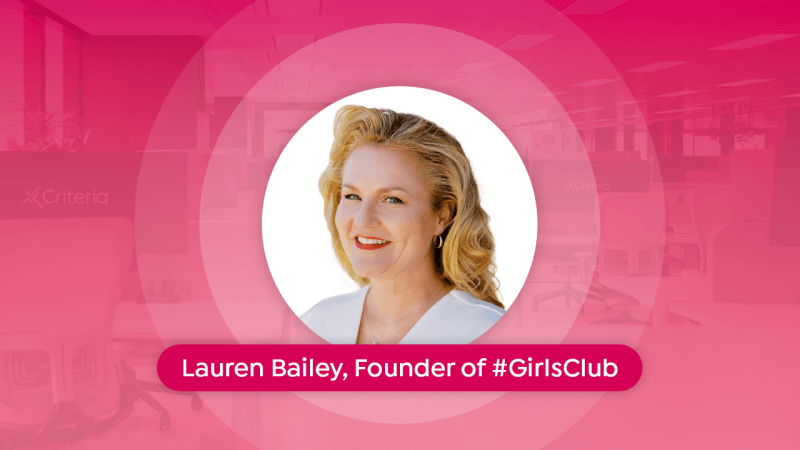Sales as a profession continues to experience a stark gender imbalance, even in an era when many companies are actively seeking to increase the diversity of their sales teams. To learn more about this uniquely complex topic, we turned to an expert: #GirlsClub founder Lauren Bailey.
#GirlsClub is a unique organization committed to changing the face of sales by empowering more women to earn roles in leadership and helping reverse the zero-growth trend of women leaders in sales. We sat down with #GirlsClub founder Lauren Bailey to talk about how companies can start hiring top female talent.
When it comes to hiring, many employers focus heavily on a person’s resume and past experience. What kind of impact does this have on female candidates who are trying to break into certain careers?
As the founder of #GirlsClub, I’ve had the honor of working closely with all levels of women in sales – from our aspiring manager cohort Proteges all the way up to Senior Executives who serve as Role Models for our community. One thing every level has in common is greater potential than her resume. This happens for one primary reason: she entered revenue – and certainly revenue leadership – later in her career than most men.
Know this for certain: a woman won’t apply for your job unless she knows she can crush it. We typically wait until we can meet 100% of the advertised criteria and feel like we can confidently do the job not just well, but very well before we apply. We’re more prone to perfectionism than we are to risk, and this makes sales less attractive than most entry-level positions to female applicants.
So as an employer, if you look only at experience, you may be inadvertently draining more than 50% of your hiring pool in a time when talent is scarcer. When I came up in sales leadership, our target seller profile had 2 years of experience, a college degree, and played a competitive sport. Today, that seller is looking for a second-level promotion if they’re still in sales. Studies show our average tenure is under two years and getting shorter.
To win in today’s market, the smart play is to hire based on attributes and abilities, not specific experience.
Do you have any tips for employers in male-dominated fields when it comes to attracting female applicants? How can they encourage more women to apply?
What an awesome question! There are some surprisingly easy wins here – and how to avoid mistakes I was making myself:
1. Eliminate the competitive language from your job descriptions and instead play up human connection, relationship-building, and service angles.
As a gender, we’re both less likely to want to compete for our compensation and less likely to bet on ourselves. We’d rather be associated with a company that cares for their customers and values our ability to connect with them, not “sell at them” to hit quota.
2. Pay high-performing women on the team for referrals.
Working moms do GREAT with at-home work hours, and former teachers and military personnel nearly always top my list of great sales hires!
3. Offer a higher base salary.
It feels counterintuitive for sellers, but let me tell you about one of my employees, CK. CK was my head of business development – she’d grown into the role from an admin. Smart, focused, hardworking, and capabilities for days. Every goal we set, she exceeded.
As we planned for our 2020 budget, I awarded her our highest salary raise. Then I asked, “Would you like to add a variable component? Let’s say 5-8% of your salary again as a potential bonus for continuing to hit targets?” We’re talking another $5-10K of “free money” and CK’s answer was, “no thanks.”
Me: “You know this is in addition to your raise, right?”
CK: “Yeah.”
Me: “And you don’t pay ME the money if you miss. It’s only upside.”
CK: “That’s just not me.”
It's hard for sales leaders to wrap our heads around that. I’ve said it myself: “the right seller with the right inherent behaviors will WANT more risk and upside!” And it’s true… except for 90% of women. Two other women who have worked for me also turned down the variable. We don’t love risk and we want to feel valued. Base over upside.
Good news: trust that the diligence, focus, passion, and care with which I see most female employees approach their job is worth the higher base rate.
4. Show her more women in the company. Diversity matters to female applicants.
If your board is still all white men, take down the picture. If your leadership team lacks diversity, take steps to address this. Having diverse representation throughout the hiring process is crucial. For example, are the only women in your hiring process the recruiters? Fix that.
Women want to see themselves represented in the companies they join. And I’ve heard enough stories of women choosing to remain unemployed instead of breaking this unspoken rule, so it’s one that should be taken seriously. Young women especially are just so much better at culture checking and making choices on behalf of diversity and inclusion than I used to be when I was coming up.
Instead of focusing on resume or experience, how do you determine if a candidate has potential? And how do you evaluate them objectively?
If you don’t have a hiring tool, get one. I’ve evaluated hundreds of companies’ hiring practices and the disparity between each hiring experience based on the front-line manager is REAL. So is the Similarity Attraction Effect: the psychological phenomenon that we like and trust people who are like us. It’s the reason “people buy from people they like,” and the reason we hire people who look like, act like, or vibe like us.
Nobody goes into a hiring process with the goal to discriminate, but we’re all fighting human nature at each step of the process not to. Tools like pre-employment assessments show us unbiased potential, capabilities, and attributes that interviews and resumes can’t demonstrate effectively. These objective tools eliminate the gut reaction and level the playing field for women. I’ve seen and used a lot of tools in my career, and I love and recommend the Criteria platform.
What tips do you have for building a hiring process that is female-friendly and inclusive to all?
Develop a new hiring matrix that trades the years of experience for essential non-experience related criteria. Try to limit the number of items on the “must have list” in your job description, since you know that women will only apply if they meet them all. Decide if the knowledge, skill, attribute, or attitude is either Critical to the Role, Nice to Have, or if it can be Learned on the Job.
Get your list to as few items as possible and then connect with your hiring team to ensure that you all agree on questions, tools, tests, or experiences you’ll use to assess each requirement. Interview current top performers at your company (and make sure to represent diversity here!) to check that your list reflects the necessary things to succeed, and then run a few mock interviews to calibrate the scoring. Finally, train all the managers and recruiters together on how to use this process, emphasizing the importance of inclusivity. During candidate evaluation, make all people feel welcome and valued. Be sure diversity is represented as best as you can in every candidate interaction.
Thank you so much for your time and insight Lauren! Do you have any final thoughts you’d like to share?
By looking beyond the resume and implementing these strategies, employers can attract and hire top female talent, creating a more diverse and inclusive workforce. In doing so, they will reap the benefits for their culture, productivity, and bottom line.





